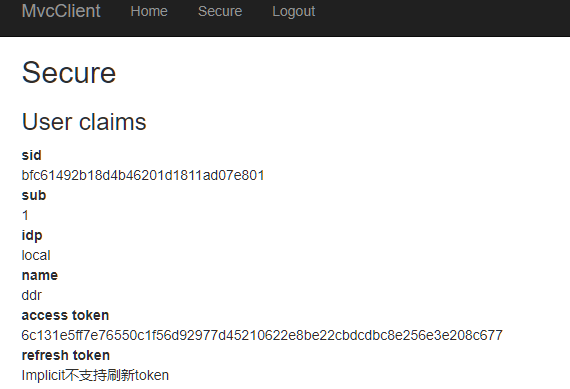IdentityServer4之Implicit(隐式许可)
参考
官方文档:3_interactive_login 、7_javascript_client
概念:隐式许可
认证服务端配置
认证服务ApiResource配置
new ApiResource("api1", "api项目 一") { ApiSecrets = { new Secret("api1pwd".Sha256()) } },
认证服务Client配置
// OpenID Connect implicit flow client (MVC) new Client { ClientId = "mvc", ClientName = "MVC Client", AllowedGrantTypes = GrantTypes.Implicit, AllowAccessTokensViaBrowser = true, AccessTokenType = AccessTokenType.Reference, RedirectUris ={ "http://localhost:5002/signin-oidc", "http://www.implicit.com/signin-oidc" }, PostLogoutRedirectUris ={ "http://localhost:5002/signout-callback-oidc", "http://www.implicit.com/signout-callback-oidc" }, AllowedScopes = { IdentityServerConstants.StandardScopes.OpenId, IdentityServerConstants.StandardScopes.Profile, "api1","api2" } },
认证服务Startup配置
public void ConfigureServices(IServiceCollection services) { services.AddMvc(); // configure identity server with in-memory stores, keys, clients and scopes services.AddIdentityServer() .AddDeveloperSigningCredential() .AddInMemoryIdentityResources(Config.GetIdentityResources()) .AddInMemoryApiResources(Config.GetApiResources()) .AddInMemoryClients(Config.GetClients()) .AddTestUsers(Config.GetUsers()); }
资源服务Api配置
资源服务器Startup配置
services.AddMvcCore() .AddAuthorization() .AddJsonFormatters(); services.AddAuthentication("Bearer") .AddIdentityServerAuthentication(options => { options.Authority = "http://localhost:5000"; options.RequireHttpsMetadata = false; options.ApiName = "api1"; options.ApiSecret = "api1pwd"; //对应ApiResources中的密钥 });
添加接口
[Route("[controller]")] [Authorize] public class IdentityController : ControllerBase { [HttpGet] public IActionResult Get() { var info = from c in User.Claims select new { c.Type, c.Value }; var list = info.ToList(); list.Add(new { Type = "api1返回", Value = DateTime.Now.ToString("yyyy-MM-dd HH:mm:ss") }); return new JsonResult(list); } }
Client客户端
(A)客户端通过向授权端点引导资源拥有者的用户代理开始流程。客户端包括它的客户端标识、请求范围、本地状态和重定向URI,一旦访问被许可(或拒绝)授权服务器将传送用户代理回到该URI。
(B)授权服务器验证资源拥有者的身份(通过用户代理),并确定资源拥有者是否授予或拒绝客户端的访问请求。
(C)假设资源拥有者许可访问,授权服务器使用之前(在请求时或客户端注册时)提供的重定向URI重定向用户代理回到客户端。重定向URI在URI片段中包含访问令牌。
(D)用户代理顺着重定向指示向Web托管的客户端资源发起请求。用户代理在本地保留片段信息。
(E)Web托管的客户端资源返回一个网页(通常是带有嵌入式脚本的HTML文档),该网页能够访问包含用户代理保留的片段的完整重定向URI并提取包含在片段中的访问令牌(和其他参数)。
(F)用户代理在本地执行Web托管的客户端资源提供的提取访问令牌的脚本。
(G)用户代理传送访问令牌给客户端。
1、JS Client
// JavaScript Client new Client { ClientId = "js", ClientName = "JavaScript Client", AllowedGrantTypes = GrantTypes.Implicit, AllowAccessTokensViaBrowser = true, //允许通过浏览器传输token RedirectUris = { "http://localhost:5009/callback.html" }, PostLogoutRedirectUris = { "http://localhost:5009/index.html" }, AllowedCorsOrigins = { "http://localhost:5009" }, AllowedScopes = { IdentityServerConstants.StandardScopes.OpenId, IdentityServerConstants.StandardScopes.Profile, "api1" } },
js client的静态资源。

2、MVC Client
JwtSecurityTokenHandler.DefaultInboundClaimTypeMap.Clear(); services.AddAuthentication(options => { options.DefaultScheme = "Cookies"; options.DefaultChallengeScheme = "oidc"; }) .AddCookie("Cookies") .AddOpenIdConnect("oidc", options => { options.SignInScheme = "Cookies"; options.Authority = "http://localhost:5000"; options.RequireHttpsMetadata = false; options.ClientId = "mvc"; options.ResponseType = "id_token token"; options.SaveTokens = true; options.GetClaimsFromUserInfoEndpoint = true; options.Scope.Add("api1"); });
需要身份授权的页面
[Authorize] public IActionResult Secure() { ViewData["Message"] = "Secure page."; return View(); }
调用Api
public async Task<IActionResult> CallApiUsingUserAccessToken() { var accessToken = await HttpContext.GetTokenAsync("access_token"); var client = new HttpClient(); client.SetBearerToken(accessToken); var content = await client.GetStringAsync("http://localhost:5001/identity"); ViewBag.Json = JArray.Parse(content).ToString(); return View("json"); }
获取token过程解析
Reference形式获取access_token
1、前后端分离形式认证
隐式许可没有获取Authorization Code的过程。
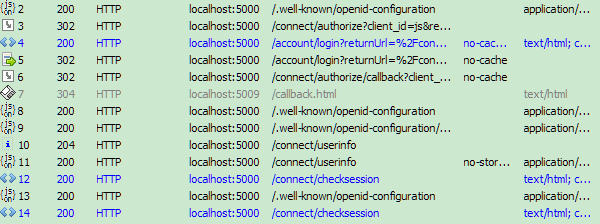
4和5是是用户登录(资源拥有者授权)。
2和3为Get请求参数如下。

使用工具请求实际得到的是一个js Web-Hosted Client Resource返回的静态脚本资源 。
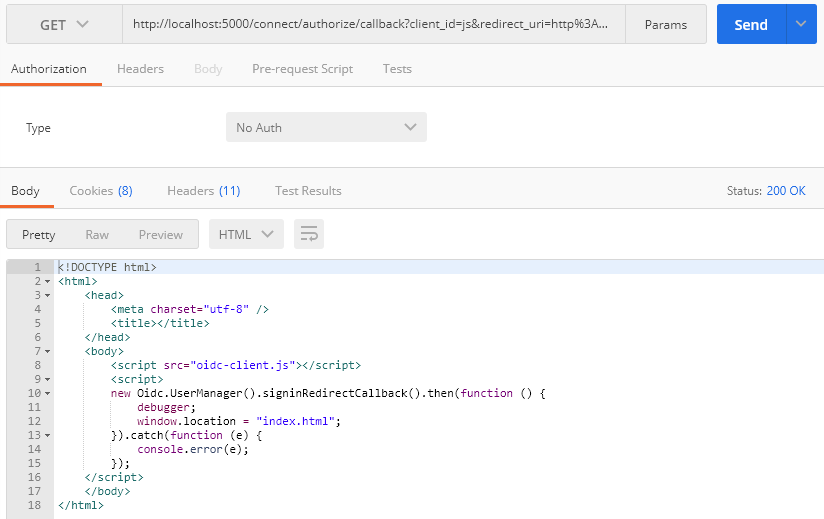
304的回调 # 后的信息不会经过js client 的服务器,直接在浏览器解析。
http://localhost:5009/callback.html# id_token=eyJhbGciOiJSUzI1NiIsImtpZCI6IjAzMTZkNWQwYTViNTgyYzc0NmJlMmVhZWU1MTg1NzhiIiwidHlwIjoiSldUIn0.eyJuYmYiOjE1MTE5NTY1NTMsImV4cCI6MTUxMTk1Njg1MywiaXNzIjoiaHR0cDovL2xvY2FsaG9zdDo1MDAwIiwiYXVkIjoianMiLCJub25jZSI6ImEyOGY5MmRiMjVmNzRkYjQ5YTRhMzU3YTY0YzA2OTU2IiwiaWF0IjoxNTExOTU2NTUzLCJhdF9oYXNoIjoiUldXMU9pTHNzYmVHek1UaHBkbE1xdyIsInNpZCI6ImZiODI5MzQzYWRjN2U4MjUxMjk1OTE1NDBmZDc3ZjBhIiwic3ViIjoiMSIsImF1dGhfdGltZSI6MTUxMTk1NjU1MywiaWRwIjoibG9jYWwiLCJhbXIiOlsicHdkIl19.av1-FqeVdobrPl1QxrIndjpzwTHgoJTclx2xwaOexDapbi-yYe8uOIBQG3hR4B4juM3nBm5GFp0873Yn_ReUD4YAxKlBJuoVxzMVIxSVB2H7RZH5wiMCktY8rgWAV4_lSfDZG1B3n4Ged8gj80b5vlt6rKs48woJiaeDemtLs0EY6lqomENy0MY1lu2TkVco_AyB_ha6jJsLXgCK8U9ttN6862h0HlvDy7KqRpTqfstkcT1JIUkooX3JfUNwru4y38HIxs55_dA9Pq8hfBK--Y7_fRW2_vnDz99Bn0kRcQcfgHXHxcovtNU1MRdFataRtjP6QyC26DyXLcr5d8_QCw& access_token=eyJhbGciOiJSUzI1NiIsImtpZCI6IjAzMTZkNWQwYTViNTgyYzc0NmJlMmVhZWU1MTg1NzhiIiwidHlwIjoiSldUIn0.eyJuYmYiOjE1MTE5NTY1NTMsImV4cCI6MTUxMTk2MDE1MywiaXNzIjoiaHR0cDovL2xvY2FsaG9zdDo1MDAwIiwiYXVkIjpbImh0dHA6Ly9sb2NhbGhvc3Q6NTAwMC9yZXNvdXJjZXMiLCJhcGkxIl0sImNsaWVudF9pZCI6ImpzIiwic3ViIjoiMSIsImF1dGhfdGltZSI6MTUxMTk1NjU1MywiaWRwIjoibG9jYWwiLCJzY29wZSI6WyJvcGVuaWQiLCJwcm9maWxlIiwiYXBpMSJdLCJhbXIiOlsicHdkIl19.s1lYjwnuj6PKYwUpKj7CNFhKPEBFqbI51UT8okg1G8d73AU1Tx1KuZpkulxeAbhIqD807TiY_A9-h1shSNTAXOhlcSGR6hZiMHcAU50nFvkNTq16j0wjeGtF5i5xlNJDwvq77cDs0rWnge9dmPtQZNPQXWfNW49_A7BRQUDiAad5S3I0juYsvYS7HThf0dGXRiJwI8ZYNMDRT2jxthZRaImuQFNK3VAFNptb8rJ2R5D3oBbHWDriJ4N-6UUE36ICPenmhy-aykGm_bNjD_unm6sEKy7hGTboGetpgt4F_4fAKJQCCrEzfUohXvQwUSEjQoE1RlZssIFCQTdYnG86sw& token_type=Bearer& expires_in=3600& scope=openid%20profile%20api1& state=49773b518261412199fb3ece49a043e1& session_state=yMpEMT7X9xYpM8aBRpJ8IWK60zUi71jXzIgRSaCHO14.6d673e3200de918c6c35a5d61b4ddd2e
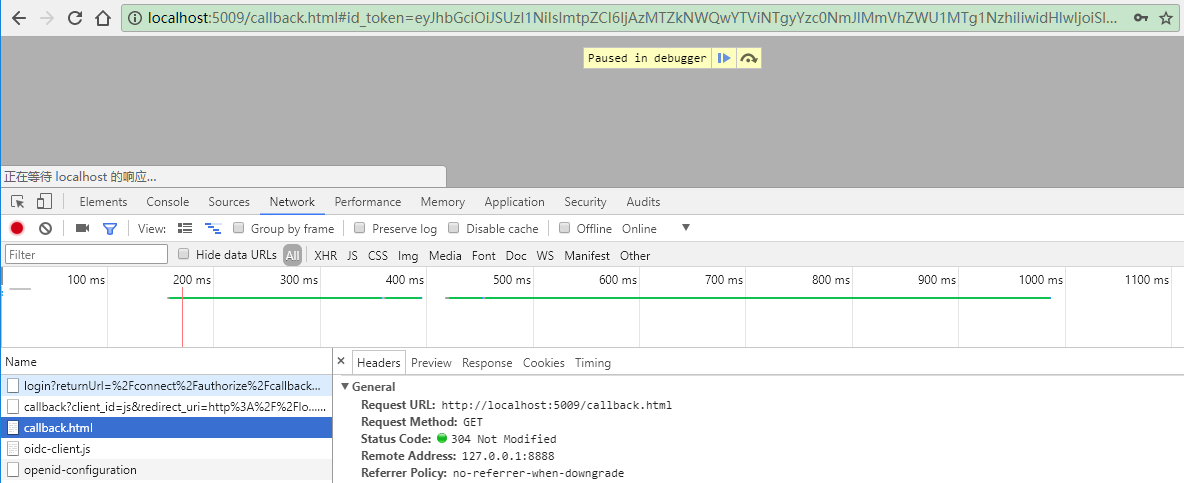
2、OpenID Connect协议认证

7和22是用户登录(资源拥有者授权)。
5和23为Get请求参数如下。

使用工具请求实际得到的是一个自动提交的表单。
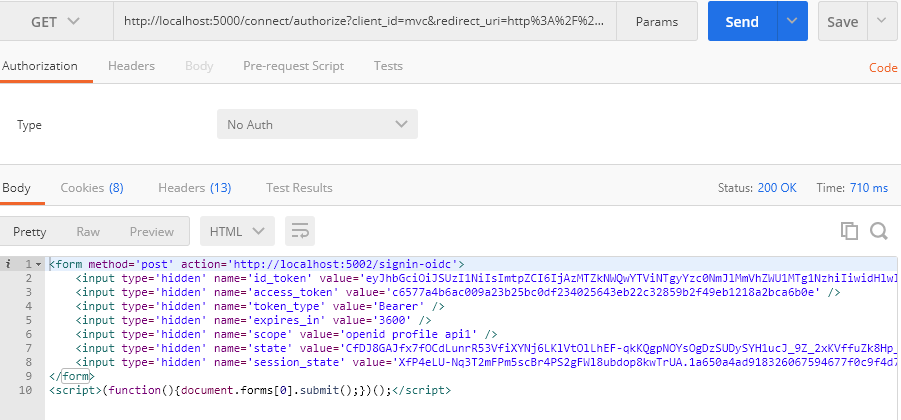
登录完成后的效果。
